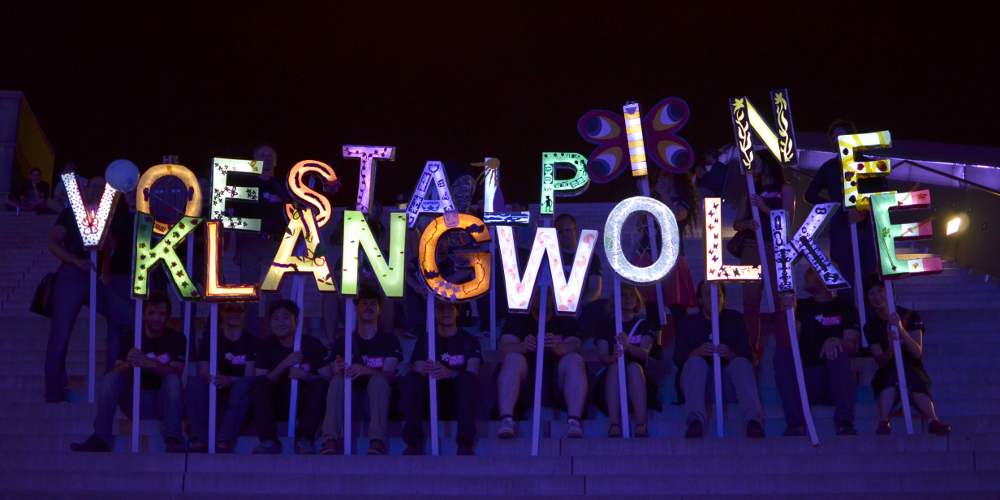 The LinzerSchnitte is a radio frequency receiver that can be programmed to respond to various different tones
The LinzerSchnitte is a radio frequency receiver that can be programmed to respond to various different tones
Did you always want to adopt a LED pixel of the Ars Electronica Center’s LED façade? Turn it on and off comfortably from home? Or control your coffee machine in sync with the LED façade? The Ars Electronica Futurelab makes this all possible with “Entangled Sparks”.
Veronika Pauser, the Futurelab staffer who heads “Entangled Sparks,” took some time out to answer a few of our questions and let us in on what the so-called LinzerSchnitte is all about and what “Connecting Cities” has to do with it.
 First layouts of the LinzerSchnitte
First layouts of the LinzerSchnitte
Veronika, you’re working on the Connecting Cities project now. So, what’s up with that?
Veronika Pauser: “Connecting Cities” is an EU project that was launched in 2012. About 15 cultural institutions within and outside the EU are involved. The objective is to present artistic and cultural content on public screens and media façades. The participating cultural institutions are working on a wide array of projects to achieve this objective. The only prerequisite is that no project may be site-specific, so it can be redeployed and staged in the other participating cities. The result is a connection among the cities. The project is running until 2016, each year with a new theme. Last year, it was “Network City” and focused on interlinking urban centers. This year’s theme is “Participatory City,” the aim of which is to get city dwellers integrated into the various projects.
 With the LinzerSchnitte the “Klangwolken ABC” was lightened up
With the LinzerSchnitte the “Klangwolken ABC” was lightened up
The so-called LinzerSchnitte was also employed for Connecting Cities, which was developed in the Futurelab …
Veronika Pauser: Exactly. The LinzerSchnitte was originally developed for the voestalpine Klangwolke in 2012, when the production’s concept was to make the Klangwolke a bit more participatory. The idea was to enable audience members to have hands-on input into the spectacle, and this gave birth to the “Klangwolken ABC” that the Linzerschnitte was an essential part of. So we staged workshops in which anyone who wanted to participate could construct their own letters and enable them to light up to the beat of the music on the evening of the voestalpine Klangwolke.
 So how exactly does a LinzerSchnitte work?
So how exactly does a LinzerSchnitte work?
Veronika Pauser: The LinzerSchnitte is a radio frequency receiver that can be programmed to respond to various different tones. Whenever the radio plays the right tone, the LinzerSchnitte reacts by flipping a switch that, in turn, permits electric current to flow. Whatever’s connected to the LinzerSchnitte is thus provided with power, and this is how we got the tiny LED-stripes in the letters to light up during the voestalpine Klangwolke 2012.
 The LinzerSchnitte and the LED facade of the Ars Electronica Center are like mirrors
The LinzerSchnitte and the LED facade of the Ars Electronica Center are like mirrors
During summer, you’ll again be holding LinzerSchnitte workshops …
Veronika Pauser: Yes indeed. In the Ars Electronica Center, participants can learn how to deal with the LinzerSchnitte and they can get busy giving free rein to their creativity.
Finally, an event will be staged during the Ars Electronica Festival in September. Every workshop participant can take godparenthood for a pixel of the Ars Electronica Center’s LED façade and connect it with his or her own LinzerSchnitte. With a Web platform user can light up their “adopted” LED-Pixel in the AEC façade right from their own homes. And vice versa: as soon as a visualization on the facade is running and the personal pixels are animated, automatically the connected apparatus to the LinzerSchnitte turns on. An apparatus can be everything, a bedside lamp or even something more unusual.
The project is entitled Entangled Sparks because it functions like a phenomenon described in quantum mechanics: a particle is inseparably linked to another. When something happens here, something also happens there, and vice-versa. That was the idea behind the whole thing.
Who can take part in these workshops?
Veronika Pauser: Anyone who possesses a modicum of technical capability and also has some basic electronic equipment at home. Participants ought to have no apprehensions when it comes to hands-on contact with electronics, and they should be very interested in technology. At present, we’re making every effort to simplify the software so the LinzerSchnitte is easy to program. And since the program code is based on the open source principle, any participant can use the code free.
Workshops will also be held in Brussels and Brisbane. What’s planned at those locations?
Veronika Pauser: People will be tinkering with the LinzerSchnitte technology there too. In Brisbane they’re going to hold a so-called Labacademy at which students will be able to use the LinzerSchnitte technology to develop interesting, creative projects of their own, the best of which will then go on display September 4-8 at the Ars Electronica Festival.
Dates for the workshops with the LinzerSchnitte at the Ars Electronica Center will be announced shortly.
